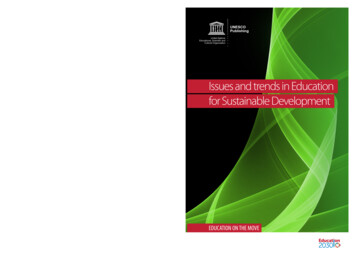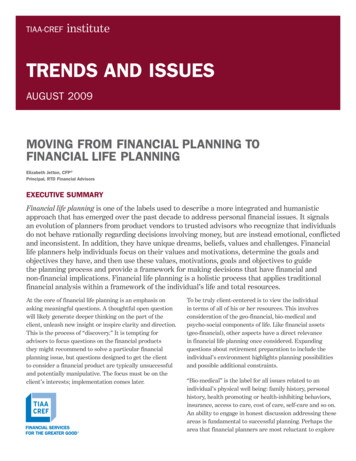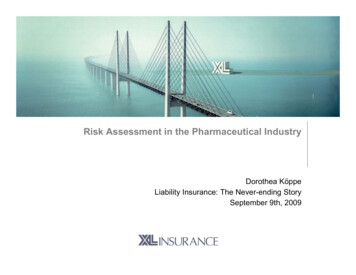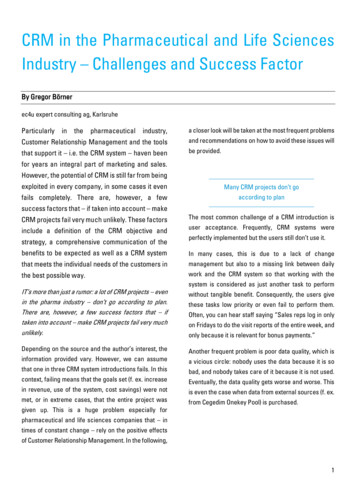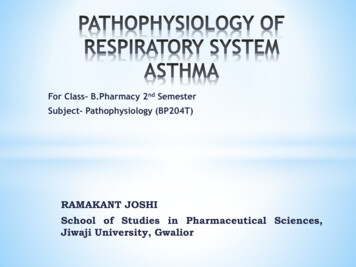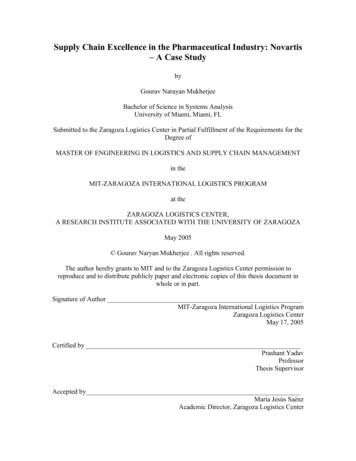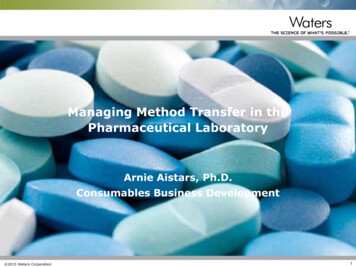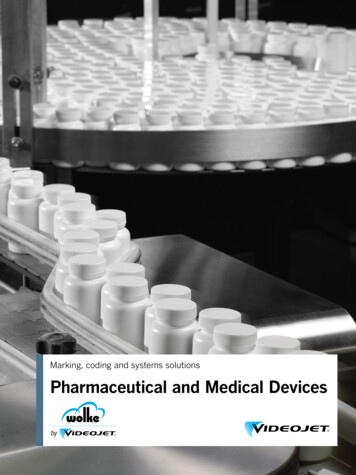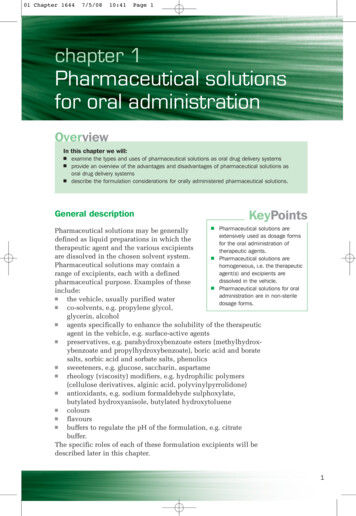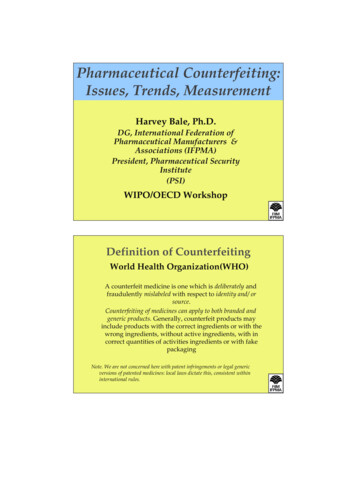
Transcription
Pharmaceutical Counterfeiting:Issues, Trends, MeasurementHarvey Bale, Ph.D.DG, International Federation ofPharmaceutical Manufacturers &Associations (IFPMA)President, Pharmaceutical SecurityInstitute(PSI)WIPO/OECD WorkshopDefinition of CounterfeitingWorld Health Organization(WHO)A counterfeit medicine is one which is deliberately andfraudulently mislabeled with respect to identity and/ orsource.Counterfeiting of medicines can apply to both branded andgeneric products. Generally, counterfeit products mayinclude products with the correct ingredients or with thewrong ingredients, without active ingredients, with incorrect quantities of activities ingredients or with fakepackagingNote. We are not concerned here with patent infringements or legal genericversions of patented medicines: local laws dictate this, consistent withininternational rules.
The Many Faces ofCounterfeit MedicinesQ. What are counterfeit medicines?A. Products marketed with intent todeceive–––––Counterfeit active/bulk ingredientsCounterfeit finished productsUnregulated diverted productsCounterfeit labelingMislabeled substances (e.g., generic antibiotics)Range of Available PrescriptionPharmaceuticals Original brand-name medicines Bioequivalent:– Unbranded generics: common in US/UK– Branded generics: common in LDC’s/Europe Non-bioequivalent:– “Similars”: prevalent in Latin America, Turkey,etc.; tending toward being close to counterfeits Counterfeits: totally deceptive and not regulatedat all; drugs diverted and mishandled; (does notinclude alleged patent infringements)
Substandard, Unregulated andCounterfeit DrugsSubstandard DrugsCounterfeitsUnregulated (similars), diverted orpoorly handled & expired drugsWhy are Medicines a Target?Medicines represent one of the most regulatedsectors of industrial activity. Why do they attractcounterfeiters?– Fakes can be made relatively cheaply (at least asprofitable as narcotics – lower risk)– Many countries, especially in the developing world lackadequate regulation and enforcement– Even in the industrialized countries, the risk ofprosecution and penalties for counterfeiting areinadequate– The way in which medicines reach the consumer is alsodifferent from other goods: the end-user has littleknowledge of the product – a ‘credence’ good
What is Particular toPharmaceutical Counterfeiting? Medicine counterfeiting is much more of a threat topublic health than to company revenues Developing countries are the worst affected whereregulatory structure is weaker and measurementand oversight is difficult; consumers in LDC’s oftenbuy Rx drugs directly over the counter Non-branded generics are very widelycounterfeited (e.g., ampicillin, paracetamol) Prices vary widely across the world, and paralleltrade is widespread, allowing counterfeit medicinesto enter the supply chain People will not knowingly buy a counterfeit drug,but consumer detection is extremely difficult: priceis not an indicator in insured marketsCurrent and Future Risks Treatment failure in malaria, TB andHIV/AIDS Growth of resistance to existing anti-infectivesfrom use of sub-par treatments Spread of drug resistant pandemics, includingHIV and influenza Use of illegal funds to finance further illegalmanufacture of medicines and even terrorism Globalization of pharmaceutical productionknow-how drives counterfeiting: supply-driven Counterfeit drugs are increasingly showing upin OECD countries (see next slide)
EU Commission: Trans-Shipments to EU a ProblemAs European officials are planning a broader strategyagainst counterfeit drugs, the issue of trans-shipment hasresurfaced. The EU Commission is warning thatcounterfeits are making their way to the EU via seeminglyinnocuous states like Japan and the U.S. [It] is nowproposing measures to increase customs enforcement andcoordination with industry. In addition, the EU plans tomeet with China in November to discuss how to curtailthe counterfeit trade. EU Customs Commissioner LaszloKovacs will be setting up a Customs CooperationCommittee there. . European officials are also eager tomeet with officials from India, Pakistan, and LatinAmerica for the same purpose.("EU commission proposes plan to boost protection against counterfeit andpirated goods," Associated Press, 11 October 2005; "Fake goods flooding EU byway of transshipment through 'safe' states," Lloyd's List, 14 October 2005).Common But Erroneous “DataPoint”“The WHO also reports that the US Food andDrug Administration estimates that more than10 percent of medicines in circulation in bothdeveloped and developing countries arecounterfeit.”Draft Final Report from Task Force 5 of the United Nations Millennium DevelopmentGoals Project: Infectious Diseases and Access to Essential Medicines (10/2004)Under both possible meanings of this sentenceit is factually wrong – it is logicallyimpossible
Statistics – Nothing PreciseAbout 85% of the world pharmaceutical market is in developed world,where counterfeits are less than 0.2% of the market. The incidence ofcounterfeiting in the remaining 15% would have to be 66% to reachthe 10% claim – and FDA denies the 10% estimate. No precise figure for the extent of counterfeit medicines ispossible: the problem is greatest – in developing countries –where the regulatory and legal oversight is weakest Evidence is consumed; deaths are attributed normally todiseases’ effects Probably is perhaps in the range of 2 percent, but this lowaverage conceals and distorts the real nature of the problem:– US, EU, Japan, Canada: 0.2%– Russia: 10% (Some survey work)– India: 15% - 20% (Hindu Business Line – 2003)– SE Asia: 5 - 10% (Some sampling)– Latin America: 10 - 20% (“Guesstimates”)– Africa: up to 60% (Anecdotal)Number of Incidents of Counterfeiting,Diversion and TheftYear Counterfeit 05*243*70*35*348**(9 months)
Top 10 in 20041. China6. Russia2. United States7. Peru3. Colombia8. Israel4. India9. South Korea5. Brazil10. United KingdomNeed for More Collective Global Action The Internet is magnifying the problem of counterfeiting Police and judicial priorities are elsewhere Ignorance about the scope of the problem and its extent insector of generic products Problem is not recognized as more than a “commercialissue”: association with “branded” products Confusion of counterfeiting issue with IP issues (“piracy”) Priority in global monitoring and control by policeauthorities given over to illegal drugs (heroin, etc.) Refusal of some regulatory agencies to admit problem WHO’s current disease focus; relatively low resourcepriority given to quality – at least until recently
Some Final Thoughts on Data Accurate estimates will be extremely difficult todevelop in foreseeable future – problem is greatestwhere measurement is most difficult; genericmedicines are widely counterfeited, but there is nocompany stake in this problem It is important to highlight incidents ofcounterfeiting, illegal diversion and theft –because they are linked Most important is to track the trends in both thelevel and geographic occurrences of counterfeiting
meet with officials from India, Pakistan, and Latin America for the same purpose. ("EU commission proposes plan to boost protection against counterfeit and pirated goods," Associated Press, 11 October 2005; "Fake goods flooding EU by way of transshipment through 'safe' states," Lloyd's List, 14 October 2005). Common But Erroneous “Data Point”
